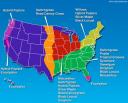Apr
14
There is a Biofuel Crop that Will Grow Near You
April 14, 2008 | 5 Comments
Last week we looked at jatropha and saw a map that shows “what biomass crops grow where” and noted that jatropha and algae were both missing. The email has seen some questions about not just missing crops, but wondering where the crops that might become fuels could be located.
That brings us to the maps about the soils and their suitability for kinds of crops. There is a huge array from swampy gooey waterlogged soils to near desert areas with little rainfall. Those are improved by drainage of the higher ground so the swampy soils can be made crop productive and irrigation for some great soils that climate has left just too dry for productivity.
Altitude also plays a role, as you get higher the availability of CO2 diminishes. Incline, or the amount of slope of land determines the limits of what can be grown. There are other attributes that can be listed, but you’re getting the idea about how difficult it is to offer a blanket answer.
The Oakridge Laboratory map above is just a general map of some, but not necessarily all of the crops that could be used to produce fuels. Three crops are grasses, switchgrass, miscanthus, and reed canary grass, plus “tropical grasses” that may prove to be an opportunity someday, and sorghum, a close relative to corn. The rest are trees species.
The plants we are most familiar with as crops range from fruit trees to grasses. These come in groups such as cereal grains like rice, wheat and corn. There are fiber crops like cotton and hemp. Oil seed crops such as soy, canola, sunflower, and palm and pulses or beans like red beans and chickpeas. Add in root plants like potato, peanut, and yams, stimulants like cocoa and coffee, sugar plants like sugarcane and sugar beet. Then top these with the fruit trees such as apple and peach and finally vegetables like lettuce and tomato.
Now with the missing jatropha, algae, the list of biomass to fuel plants and the current crops there is quite a list. Now add the forestry gleanings and wood products for fuel and it becomes apparent that there is a huge potential.
This map is the first of a set that covers the planet’s entire land mass by crop type. Missing are the biofuel crops as a category, jatropha, algae, and forestry. The link is to a pdf that covers the crops by groups as cereals, fibers, oils, pulses, roots and tubers, stimulants, sugars, fruits and vegetables. What glares out is vast areas of marginal lands that could be used for arid crops, and the great swath of territory that could be thermal or photovoltaic solar collection zones.
Wherever you are, the land will be fit for a list of uses. This link will bring you a pdf that shows what quality of land is where in the U.S. The text will explain in some detail what the classifications mean. What matters is the soil’s ability to function under the demands of the crops selected. That is a capacity, or an ability to sustain a use. In much of the U.S., crop rotations, alternating crops each year, allows soils to recover from one crop while providing another.
Perhaps the interesting map is the one that shows the average net cash return per acre by county. The concentration in Florida, Arizona and California has to make many landowners and farmers across the U.S. wonder.
This post while meant to answer some emails really serves to set up many more questions. In truth and in point of fact, when it comes to biomatter for fuels we are in the midst of the early questions.
It may be more adroit to think with this assumption, “Some fuel crop will grow here, what business model will bring biofuel to market?”
Comments
5 Comments so far






These maps highlight a crucial point: bio-energy has to be customized to local conditions. Bio-energy is a local and regional solution to local and regional problems.
It is inappropriate for national governments to mandate particular bio-energies over others. The local solution has to be matched to both the local problem and the local opportunities–including what type of crop or biomass grows well and can be processed economically in the region.
That means there will have to be a lot more regional biomass processing plants and better local infrastructures for collecting, pre-processing, and shipping biomass to the final processing plant.
Meanwhile, the world can starve! Thanks, biofuels!
I would like to say “wow” what a inspiring post. This is really great. Keep doing what you’re doing!!
Y’all entirely forgot one of the cheapest and most productive biomass crops – sugarcane! Any place wet enough in the subtropical region and that stuff grows incredibly fast. Take a look at what Brazil has done with biofuels and you’ll see why sugarcane is the way to go.
I’ve been checking your blog for a while now, seems like everyday I learn something new 🙂 Thanks